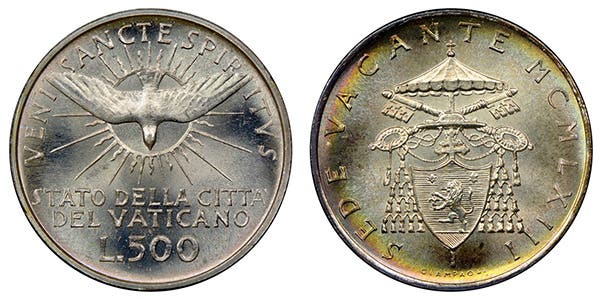Ukraine Replaces Notes with Coins
Countries are known to have converted a single bank note denomination into a coin or a coin into a bank note denomination at a time, but four denominations at once…
Countries are known to have converted a single bank note denomination into a coin or a coin into a bank note denomination at a time, but four denominations at once is unusual. Ukraine recently not only stopped issuing four bank note denominations in favor of these same denominations being issued as coins, but it also introduced price rounding rules—with taxes added to the bill after this fact.
Ukraine is now going through its first currency changes since its national hryvnia currency system was introduced in the early 1990s as Ukraine became independent of the quickly collapsing Soviet Union.
The 1-, 2-, 5-, and 25-kopek coins will be removed from circulation (the 1, 10 and 50 kopek will remain as legal tender). The four smallest bank note denominations are being replaced with coins. The new denomination coins have a different weight, size, thickness and edge treatment to those already in circulation. Nickel-plated zinc composition 5- and 10-hryvnia coins will have an electromagnetic signal to assist with their identification.
New bank notes will be printed on two-ply, formaldehyde-free, paper substrate that will integrate new security features into the design, without being limited to those specifically for paper substrates. Notes will have new designs, be embedded with a magnetic window thread, and new optic elements.
Volodymyr Bahlai is the director-general of the Banknote Printing and Minting Works. According to Bahlai, “We already produced bank notes for other countries, so there was never a discussion as to whether to outsource the printing. We just needed to renovate the facilities we had and bring the production cycle to the highest current international standards.”
Bahlai said the coin and bank note changes will save the NBU more than $35 million over the next 20 years.
Ukraine initially introduced the karbovanets as its currency. Rampant inflation soon decimated the karbovanets. In late 1996, the hryvnia was quietly introduced by presidential decree at a rate of one hryvnia to 100,000 karbovanets. Bank accounts were converted automatically, while merchants were allowed to accept karbovanets, but were required to give change at the correct exchange rate in hryvnia. About 56 percent of the karbovanets were successfully converted to hryvnia within five days of the currency reform.
The National Bank of Ukraine introduced 1992-dated 1-, 2-, 5-, 10-, and 20-hryvnias bank notes in 1996. The notes had been printed and stockpiled in 1992 by the Canadian Bank Note Company. Notes in denominations of 2, 5, and 10 hryvnia were printed two years later. Notes in denominations of 50 and 100 hryvnias were printed but not released as the economic crisis was being controlled. The 200 hryvnia would be issued in 2001, 500 hryvnia in 2006, and the 1,000 hryvnia in 2019. In 2016, the NBU paper factory started producing banknote paper using flax instead of cotton.
Coins were struck in denominations between one and 50 kopeks during 1992, but not released until 1996. A 1-hryvnia coin was added one year later.
In 1994 the British security printing firm of De La Rue printed Ukrainian bank notes in cooperation with the NBU beginning at the time of the opening of the national mint. Ukraine stopped issuing 1- and 2-kopek coins in 2013 due to the expense of producing them, officially withdrawing the two denominations on October 1, 2019.
Today, despite the devaluation of the currency since its introduction, all kopek coins and all low-value hryvnia notes (including the 1 hryvnia) remain as legal tender. According to the NBU, the 1,000-hryvnia bank note was introduced to streamline the number of coins and bank notes in circulation.
According to NBU Deputy Director of the Cash Circulation Department Oxsana Galyts, “Compared to other countries in the region, we had too many denominations. So, we looked globally at what was viewed as best practice and aligned our new series.”
Galyts said the bank consulted with the Czech National Bank, Scandinavian institutions, and others that have issued fewer denominations (between four and six) than are international averages prior to making any changes to the Ukrainian currency system. Surveys of Ukrainian citizens indicated 90 percent of the public supported withdrawing small denominations.
According to Galyts, “The most useful discussions were with the commercial banks. We asked them which denominations were used the most, which were the most costly to handle and which they felt would have the most benefit to the public. Ultimately, we went with their decision.”








